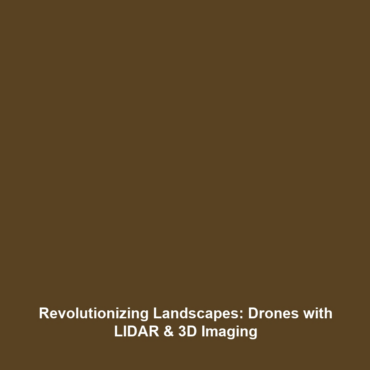How Drones Equipped with LIDAR and High-Resolution Cameras Create 3D Models of Landscapes
Introduction
Drones equipped with LIDAR (Light Detection and Ranging) and high-resolution cameras have revolutionized the field of topographic mapping and landscape modeling. These technologies enable researchers to create precise and intricate 3D models of various terrains, providing valuable insights into environmental and geological processes. Within the broader scope of Drones in Science, this innovation holds significant implications for ecological monitoring, urban planning, and natural disaster management.
Key Concepts
Understanding how drones equipped with LIDAR and high-resolution cameras create 3D models of landscapes involves several key concepts:
- LIDAR Technology: LIDAR utilizes laser beams to measure distances, generating detailed measurements that can be used to create 3D models.
- High-Resolution Imaging: High-resolution cameras capture detailed visual data that, when combined with LIDAR data, enriches the 3D representation of the landscape.
- Data Processing: Advanced software is required to process the vast amounts of data generated, transforming raw measurements into coherent 3D visualizations.
These components collectively contribute to the effectiveness of drones in science, enabling detailed landscape analysis that was previously time-consuming and labor-intensive.
Applications and Real-World Uses
Drones equipped with LIDAR and high-resolution cameras have numerous practical applications across various fields:
- Environmental Monitoring: Researchers can assess changes in ecosystems, monitor wildlife habitats, and evaluate the impact of climate change.
- Urban Planning: City planners utilize 3D models to design infrastructure, analyze urban sprawl, and promote sustainable development.
- Agriculture: Farmers use drones to optimize land use, analyze crop health, and manage resources more efficiently.
- Disaster Management: In the aftermath of natural disasters, drones can quickly survey damaged areas to aid in recovery efforts.
These applications illustrate how how drones equipped with LIDAR and high-resolution cameras are used in Drones in Science to address real-world challenges effectively.
Current Challenges
Despite the advancements in using drones equipped with LIDAR and high-resolution cameras, several challenges remain:
- High Costs: The equipment, maintenance, and data processing capabilities can be expensive, limiting access for smaller organizations.
- Data Overload: Processing and interpreting vast amounts of data generated by these technologies can be time-consuming and require specialized skills.
- Regulatory Restrictions: Drone usage is subject to strict regulations that can impact flight operations, especially in urban environments.
Addressing these challenges of how drones equipped with LIDAR and high-resolution cameras create 3D models of landscapes is essential for maximizing their benefits in the scientific community.
Future Research and Innovations
As technology advances, several promising innovations are on the horizon that could enhance the capabilities of drones in landscape modeling:
- Integration of AI: Artificial intelligence can improve data analysis and enhance model accuracy by learning from past data.
- Improved Sensor Technology: Next-generation sensors could provide even higher resolution images and more accurate LIDAR measurements.
- Enhanced Autonomy: Future drones may have improved autonomous capabilities, allowing them to conduct surveys with minimal human intervention.
These breakthroughs could significantly influence the future of Drones in Science, transforming how we understand and interact with various landscapes.
Conclusion
In summary, drones equipped with LIDAR and high-resolution cameras represent a transformative tool in landscape modeling, offering unparalleled insights and opportunities in scientific research. As the field continues to evolve, addressing existing challenges and leveraging future innovations will be crucial in maximizing the impact of this technology. To learn more about the applications of drones in science, explore our other resources on applications of drones and challenges in drone technology.

Leave a Reply